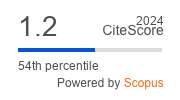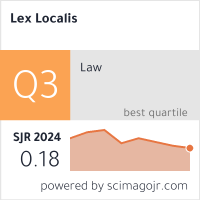Is There a Trade-off Between Sustainability and Competition Goals in Public Procurement? Evidence from Slovenia
DOI:
https://doi.org/10.52152/22.1.49-70(2024)Keywords:
horizontal policies, competition, green public procurement, socially responsible public procurement, sustainable development goalsAbstract
Over the past decade, public procurement goals have expanded from obtaining free competition and lowest prices to achieving objectives of “horizontal” policies that take into account ecological and social aspects. However, the Tinbergen Rule states that one instrument should be matched with one goal, while using one instrument for achieving multiple goals would undermine its effectiveness. In this paper, we will examine whether implementation of “horizontal” public procurement policies related to green public procurement, socially responsible public procurement and the promotion of micro, small and medium enterprises’ participation affect achievement of the “primary” public procurement goal of free competition. Our study is based on empirical data on more than 65,000 public procurements carried out in Slovenia during the period 2016-2019.
References
Arrowsmith, S. (2009) Application of the EC Treaty and directives to horizontal policies: a critical review, In: Arrowsmith, S. & Kunzlik, P. (eds.) Social and Environmental Policies in EC procurement Law: New Directives and New Directions (Cambridge: University Press), pp. 147-248.
Arrowsmith, S. (2010) Horizontal policies in public procurement: a taxonomy, Journal of Public Procurement, 10(2), pp. 149–186, https://doi.org/10.1108/JOPP-10-02-2010-B001.
Austin, P. C. (2009) Using the standardized difference to compare the prevalence of a binary variable between two groups in observational research, Communications in statistics-simulation and computation, 38(6), pp. 1228-1234, https://doi.org/10.1080/03610910902859574.
Bali, A. S., Howlett, M., Lewis, J. M. & Ramesh, M. (2021) Procedural policy tools in theory and practice, Policy and Society, 40(3), pp. 295-311, https://doi.org/10.1080/14494035.2021.1965379.
Bayarçelik, E. B., Taşel, F. & Apak, S (2014) A research on determining innovation factors for SMEs, Procedia-Social and Behavioral Sciences, 150, pp. 202–211, https://doi.org/10.1016/j.sbspro.2014.09.032.
Bulow, J. I. & Klemperer, P. D. (1994) Auctions vs. negotiations, American Economic Review, pp. 180–194, https://doi.org/10.3386/w4608.
Burgi, M. (2010) Secondary Considerations in Public Procurement in Germany, The Law of Green and Social Procurement in Europe, pp. 105–142.
Clark, M. & Moutray, C. (2004) The future of small businesses in the US federal government marketplace, Journal of Public Procurement, 4(3), pp. 450–470, https://doi.org/10.1108/JOPP-04-03-2004-B006.
Cohen, J. (2013) Statistical power analysis for the behavioral sciences (Routledge).
Čudanov, M., Jovanović, P. & Jaško, O. (2018) Influence of the Public Procurement Procedure Type on the Duration of Public Procurement, Lex Localis-Journal of Local Self-Government, 16(2), pp. 361–378, https://doi.org/10.4335/16.2.361-378(2018).
De Oliveira, A., Fabregas, A. & Fazekas, M. (2019) Strategic Sourcing 2.0: Improving Fiscal Efficiency Using Big Data Conference Paper:” Public Procurement: Global Revolution IX” at the University of Nottingham, available at: https://www.researchgate.net/publication/348408753_Strategic_Sourcing_20_Improving_Fiscal_Efficiency_Using_Big_Data (June, 2021).
Demircioglu, M. A. & Vivona, R. (2021) Positioning public procurement as a procedural tool for innovation: an empirical study, Policy and Society, 40(3), pp. 379–396, https://doi.org/10.1080/14494035.2021.1955465.
Elberfeld, W. & Wolfstetter, E. (1999) A dynamic model of Bertrand competition with entry International Journal of Industrial Organization, 17(4), pp. 513–525, https://doi.org/10.1016/S0167-7187(97)00054-4.
European Commission (2014) Directive 2014/24/EU, available at: https://www.legislation.gov.uk/eudr/2014/24/contents (June 16, 2023).
European Commission (2017a) European semester thematic factsheet: public procurement, available at: https://policycommons.net/artifacts/2035650/european-semester-thematic-factsheet/2788093 (June 16, 2023).
European Commission (2017b) Making Public Procurement Work in and for Europe, available at: https://ec.europa.eu/docsroom/documents/25612 (June 16, 2023).
European Commission (2019) Small Businees Act Fact sheet, Slovenia, available at: https://ec.europa.eu/docsroom/documents/38662/attachments/26/translations/en/renditions/native (June 16, 2023).
European Commission (2021a) Buying Social: A Guide to Taking Account of Social Considerations in Public Procurement, available at: https://op.europa.eu/en/publication-detail/-/publication/47c69b3a-cfcf-11eb-ac72-01aa75ed71a1/language-en (June 16, 2023).
European Commission (2021b) European Green Deal, available at: https://ec.europa.eu/info/strategy/priorities-2019-2024/european-green-deal_en (June 16, 2023).
European Commission (2022) Internal Market, Industry, Entrepreneurship and SMEs, available at: https://ec.europa.eu/growth/single-market/public-procurement_en (June 16, 2023).
Fazekas, M. & Kocsis, G. (2020) Uncovering high-level corruption: cross-national objective corruption risk indicators using public procurement data, British Journal of Political Science, 50(1), pp. 155–164, https://doi.org/10.1017/S0007123417000461.
Gineitiene, Z. & Serpytis, K. (2011) The Impact of Competition and Purchase Volume on the Price in Public Procurement Tenders, Socialiniu Mokslu Studijos, 3(2), pp. 473–485.
Grega, M. & Nemec, J. (2015) Factors influencing final price of public procurement: evidence from Slovakia. Procedia Economics and Finance, 25, pp. 543–551, https://doi.org/10.1016/S2212-5671(15)00768-6.
Gupta, S. (2002) Competition and collusion in a government procurement auction market, Atlantic Economic Journal, 30, pp. 13–25, https://doi.org/10.1007/BF02299143.
Hoekman, B., Shingal, A., Eknath, V. & Ereshchenko, V. (2022) COVID‐19, public procurement regimes and trade policy, The World Economy, 45(2), pp. 409-429, https://doi.org/10.1111/twec.13118.
Hyytinen, A., Lundberg, S. & Toivanen, O. (2018) Design of public procurement auctions: Evidence from cleaning contracts, The RAND Journal of Economics, 49(2), pp. 398–426, https://doi.org/10.1111/1756-2171.12232.
Iimi, A. (2006) Auction reforms for effective official development assistance, Review of Industrial Organization, 28, pp. 109–128, https://doi.org/10.1007/sl 11 51-006-00 12-x.
Jovanović, P., Delibašić, B. & Čudanov, M. (2022) Organisational Archetypes in Public Procurement, Lex Localis-Journal of Local Self-Government, 20(1), pp. 101–127, https://doi.org/10.4335/20.1.101-127(2022).
Kim, T. K. (2015) T test as a parametric statistic, Korean journal of anesthesiology, 68(6), pp. 540-546, https://doi.org/10.4097/kjae.2015.68.6.540.
Li, T. & Zheng, X. (2009) Entry and competition effects in first-price auctions: Theory and evidence from procurement auctions, The Review of Economic Studies, 76(4), pp. 1397–1429, https://doi.org/10.1111/j.1467-937X.2009.00558.x.
Lundberg, S. & Marklund, P.-O. (2018) Green public procurement and multiple environmental objectives, Economia e Politica Industriale, 45(1), pp. 37–53, https://doi.org/10.1007/s40812-017-0085-6.
Lundberg, S., Marklund, P.-O., Strömbäck, E., & Sundström, D. (2015) Using public procurement to implement environmental policy: an empirical analysis, Environmental Economics and Policy Studies, 17, pp. 487–520, https://doi.org/10.1007/s10018-015-0102-9.
Milosavljević, M., Radonovanović, S. & Delibašić, B. (2021) Evaluation of public procurement efficiency of the EU countries using preference learning TOPSIS method, Economic Computation and Economic Cybernetics Studies and Research, 55(3), pp. 187-202, https://doi.org/10.24818/18423264/55.3.21.12.
National Audit Office (2023) Lessons learned: competition in public procurement, available at: https://www.nao.org.uk/wp-content/uploads/2023/07/lessons-learned-competition-in-public-procurement.pdf (September 15, 2023).
Nazzini, R. (2018) Extempore observations on bid-rigging in public procurement: towards a virtuous circle of detection, punishment and compliance, available at: https://ssrn.com/abstract=3112577 (June 16, 2023).
OECD (2018) SMEs in Public Procurement, available at: https://doi.org/10.1787/9789264307476-en (June 16, 2023)
OECD (2020) Integrating responsible business conduct in public procurement, available at: https://www.oecd.org/publications/integrating-responsible-business-conduct-in-public-procurement-supply-chains-c5350587-en.htm (June 16, 2023).
Olsson, D. & Öjehag-Pettersson, A. (2020) Buying a sustainable society: the case of public procurement in Sweden Local environment, 25(9), pp. 681-696, https://doi.org/10.1080/13549839.2020.1820471.
Overdevest, C. & Zeitlin, J. (2014) Assembling an experimentalist regime: Transnational governance interactions in the forest sector, Regulation & Governance, 8(1), pp. 22–48, https://doi.org/10.1111/j.1748-5991.2012.01133.x.
Pouikli, K. (2021) Towards mandatory Green Public Procurement (GPP) requirements under the EU Green Deal: reconsidering the role of public procurement as an environmental policy tool, ERA Forum, 21(4), pp. 699–721, https://doi.org/10.1007/s12027-020-00635-5.
Rao, C. R. (2002) Karl Pearson chi-square test the dawn of statistical inference Goodness-of-fit tests and model validity, pp. 9-24 https://doi.org/10.1007/978-1-4612-0103-8_2.
Ryu, Y. & Sueyoshi, T. (2021) Examining the relationship between the economic performance of technology-based small suppliers and socially sustainable procurement. Sustainability, 13(13), p. 7220, https://doi.org/10.3390/su13137220.
Sen, S., Savitskie, K., Mahto, R. V, Kumar, S. & Khanin, D. (2022) Strategic flexibility in small firms, Journal of Strategic Marketing, 31(5), pp. 1053-1070, https://doi.org/10.1080/0965254X.2022.2036223.
Siddiqui, K. (2020) The Impact of COVID-19 on the Global economy, available at: https://worldfinancialreview.com/the-impact-of-covid-19-on-the-global-economy (June 16, 2023).
Sönnichsen, S. D. & Clement, J. (2020) Review of green and sustainable public procurement: Towards circular public procurement, Journal of Cleaner Production, 245 , p. 118901, https://doi.org/10.1016/j.jclepro.2019.118901.
Szymanski, S. (1996) The impact of compulsory competitive tendering on refuse collection services, Fiscal Studies, 17(3), pp. 1–19.
Tátrai, T., Vörösmarty, G. & Juhász, P. (2023) Intensifying Competition in Public Procurement,Public Organiziation Review, https://doi.org/10.1007/s11115-023-00742-0.
Tepper, P., McLennan, A., Hirt, R., Defranceschi, P., Caimi, V. & Elu, A. (2020) Making Socially Responsible Public Procurement Work: 71 Good Practice Case, available at: https://www.socioeco.org/bdf_fiche-document-7229_en.html (June 16, 2023).
Treumer, S. (2010) Green Public Procurement and Socially Responsible Public Procurement: An Analysis of Danish Regulation and Practice, In Caranta R. & Trybus M. (eds) The Law of Green and Social Procurement in Europe, pp. 53-73, DJØF, available at: https://eplgroup.eu/wp-content/uploads/2016/06/EPLS.Vol2_.GreenSocialProcurement.pdf.
Tukiainen, J. & Halonen, K.-M. (2020) Competition and litigation in Swedish public procurement, available at: https://www.konkurrensverket.se/globalassets/dokument/informationsmaterial/rapporter-och-broschyrer/uppdragsforskning/forsk-rapport_2020-1_competition-and-litigation-in-swedish-public-procurement.pdf (June 16, 2023).
United Nations (2015) 2030 Agenda for Sustainable Development, available at: https://www.coe.int/en/web/programmes/un-2030-agenda (June 16, 2023).
United Nations (2020) World social report 2020: Inequality in a rapidly changing world, available at: https://www.un.org/development/desa/dspd/wp-content/uploads/sites/22/2020/02/World-Social-Report2020-FullReport.pdf (June 16, 2023).
Downloads
Published
Issue
Section
License
Copyright (c) 2024 Lex localis - Journal of Local Self-Government

This work is licensed under a Creative Commons Attribution-NonCommercial-NoDerivatives 4.0 International License.








